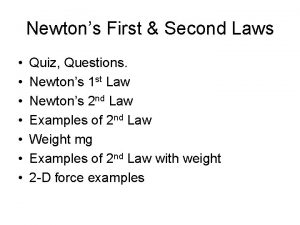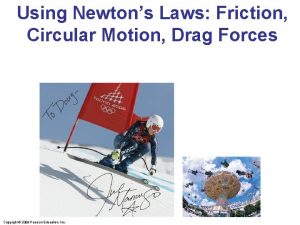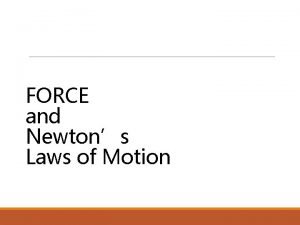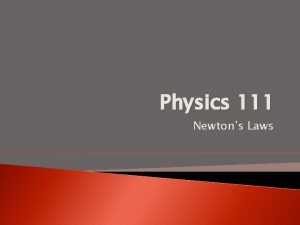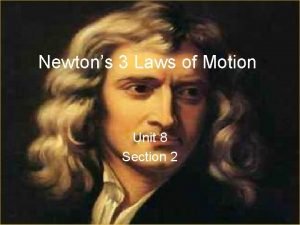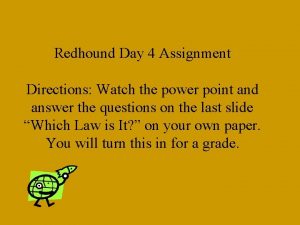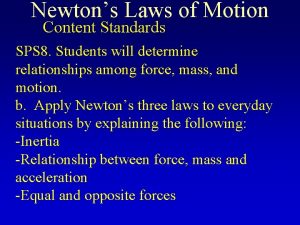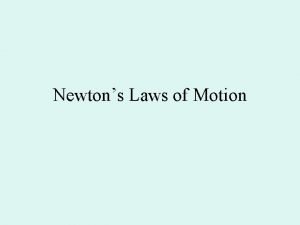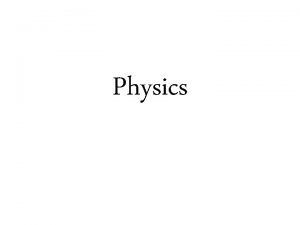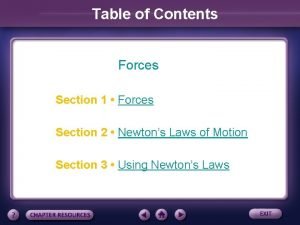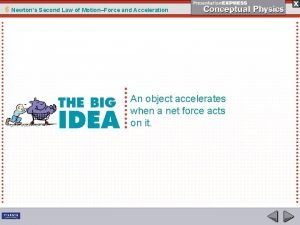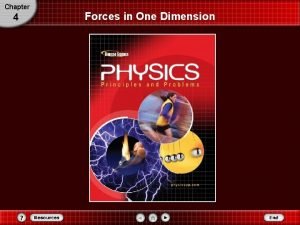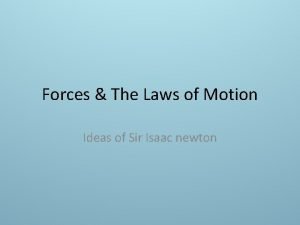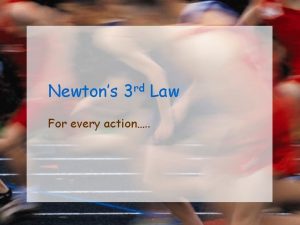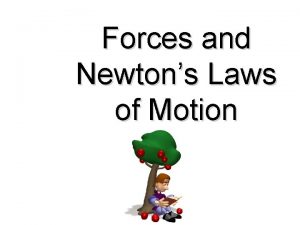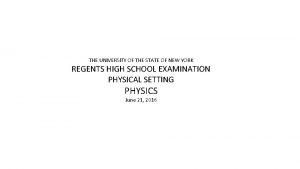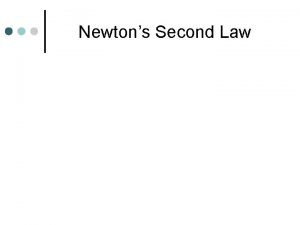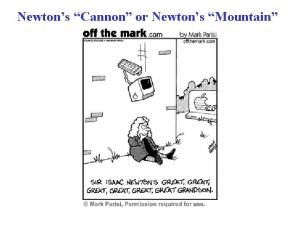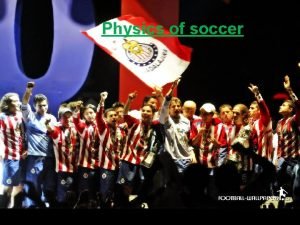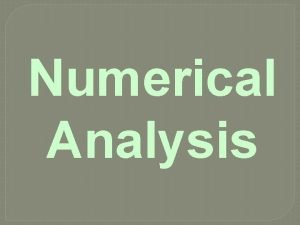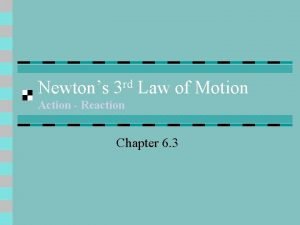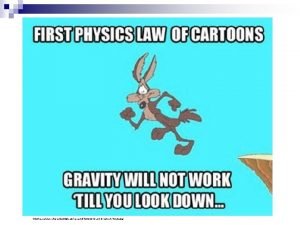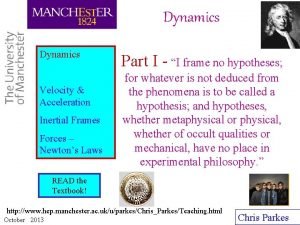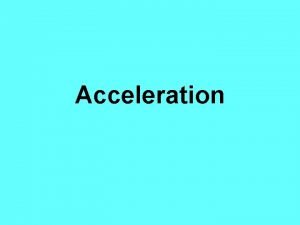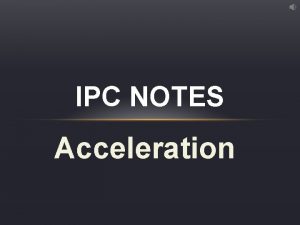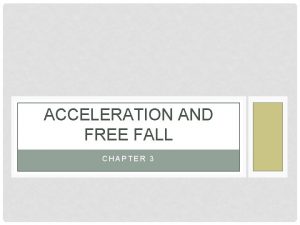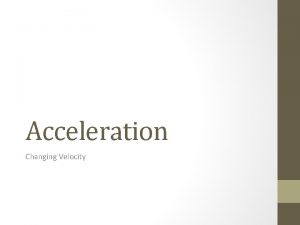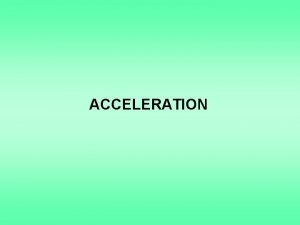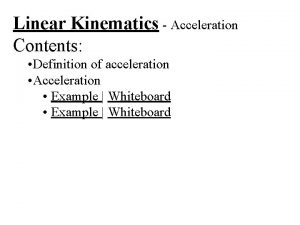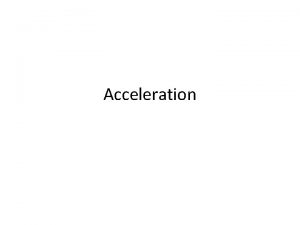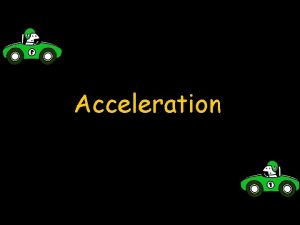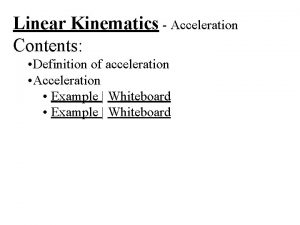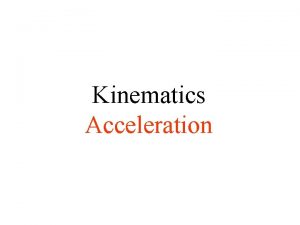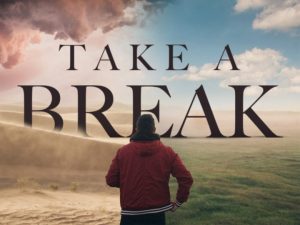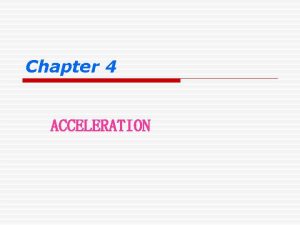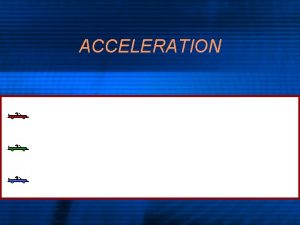Forces Acceleration Newtons Laws Newtons Laws Forces 1




















































- Slides: 52

Forces, Acceleration, Newton’s Laws

Newton’s Laws Forces 1 Forces 2 Forces 3 Forces 4 10 10 10 20 20 20 30 30 30 40 40 40 50 50 50

Question 1 - 10 The amount of matter in an object is called ______

Answer 1 – 10

Question 1 - 20 • What is Newton’s 2 nd Law?

Answer 1 – 20 Acceleration depends on the object’s mass and on the net force action on the object: • Acceleration =net force /mass • 2 children in a wagon with you pulling – acceleration is faster because the mass is lighter. If you are in the wagon and the children are pulling- the acceleration decreases because mass increases.

Question 1 - 30 • For every action, there is an _____ and ________________. • Which Newton’s Law is this?

Answer 1 – 30 Equal and opposite REACTION Newton’s Third Law of Motion

Question 1 - 40 • What is

Answer 1 – 40 Newton’s 3 rd law states that as one object exerts a force on another object, the 2 nd object exerts a force of equal strength in the opposite direction of the 1 st.

Question 1 - 50 • What is inertia?

Answer 1 – 50 • Inertia is an object’s resistance to change in motion. The greater the MASS, the greater the INERTIA • Ex: An empty aquarium is easier to move than one full of water!

Question 2 - 10 • Give an example of a balanced force

Answer 2 – 10 • Two people exerting forces on a box. If the force each person exerts is EQUAL, then it is considered a balanced force.

Question 2 - 20 • The force of gravity of a person or object at the surface of a planet is known as _______

Answer 2 – 20 Weight

Question 2 - 30 When a car stops at a stop light and you keep moving forward as the passenger, this is an example of ______. Which of Newton’s Laws is this?

Inertia Newton’s 1 st Law of Motion

Question 2 - 40 What is unbalanced forces?

• Unbalanced forces can cause an object to start moving, stop moving, or change direction. Ex: Two people exert forces on the box in the same direction; the box moves 25 N + 25 N = 50 N Or a drop on a roller coaster ride

• The tendency of an object to resist any change of motion is known as _____.

Answer 2 – 50 EX: When a car stops suddenly, but you keep moving forward until your seat belt stops you.

Question 3 - 10 • Find the net force of two forces: • 15 N 30 N

Answer 3 – 10 • 15 N

Question 3 - 20 • Find the net force of two forces: • 50 N 50 N

Answer 3 – 20 Zero This is a Balanced force

Question 3 - 30 • Find the net force of two forces: 35 N 15 N

Answer 3 – 30 50 N

Question 3 - 40 Solve: • As a roller coaster car starts down a slope, its speed is 4 m/s. But 3 seconds later, at the bottom, its speed is 22 m/s. What is its average acceleration?

Answer 3 – 40 • Acceleration= Final Speed – Initial Speed • Time 22 m/s – 4 m/s 3 s 18 m/s 3 = 6 m/s�

Question 3 - 50 What is acceleration?

Answer 3 – 50 The rate at which velocity changes; increasing speed, decreasing speed; or changing direction

Question 4 - 10 What is velocity? What is the equation to find velocity?

Answer 4 – 10 • Speed in a given direction. • Velocity = Distance/Time (with direction)

Question 4 - 20 • What is the equation for Speed?

Answer 4 – 20 Speed = Distance Time

Question 4 - 30 • Solve: • A cyclist travels 32 km during the first 2 hours. Then the cyclist travels 13 km during the next hour. Find the average speed of the cyclist.

Answer 4 – 30 Average speed of the cyclist is the total distance divided by the total time: • Total distance = 13 km + 32 km = 45 km • Total Time = 2 h + 1 h = 3 h • Average speed = 45 km • 3 h • = 15 km/h

Question 4 - 40 What is the Law of Universal Gravitation?

Answer 4 – 40 Two objects always exert (apply) gravitational forces on each other.

Question 4 - 50 A force that rubs against the surface of another surface is called ________.

Answer 4 – 50 FRICTION

Question 5 - 10 • If you know a car travels 30 km in 20 minutes, you can find its ______.

Answer 5 – 10 • Speed = Distance/time

Question 5 - 20 • You do not know an object’s velocity until you know its ______ and ______.

Answer 5 – 20 Speed and direction

Question 5 - 30 What is force?

Answer 5 – 30 A lift, pull, or push that gives energy to an object, sometimes causing it to start moving, stop moving, or change direction.

Question 5 - 40 • Name the 3 types of acceleration.

Answer 5 – 40 • Increasing speed • Decreasing speed • Changing direction

Question 5 - 50 To increase an objects momentum you need to increase its a. Force and friction b. velocity or mass c. acceleration and friction

Answer 5 – 50 b. Mass or velocity
 Centripetal acceleration ac
Centripetal acceleration ac Centripetal acceleration tangential acceleration
Centripetal acceleration tangential acceleration Angular acceleration formula
Angular acceleration formula Radial acceleration
Radial acceleration Angular acceleration and linear acceleration
Angular acceleration and linear acceleration Newtons law quiz
Newtons law quiz Newtons first lw
Newtons first lw Law of friction
Law of friction Newtons 3 laws
Newtons 3 laws The three laws of motion
The three laws of motion Abcd8n
Abcd8n Newtons laws
Newtons laws Newtons laws definitions
Newtons laws definitions It's friday night and skyler has been assigned
It's friday night and skyler has been assigned Third law of newton
Third law of newton Newton's third law
Newton's third law Newtons laws od motion
Newtons laws od motion Newton's laws
Newton's laws 3 laws of newton
3 laws of newton Newton three law
Newton three law Section 3 using newtons laws
Section 3 using newtons laws Newton's laws
Newton's laws Find the mass of a football player who weighs 1250 n
Find the mass of a football player who weighs 1250 n Laws of motion
Laws of motion Problem 3
Problem 3 Vector diagram
Vector diagram Section 1 forces
Section 1 forces Newton's laws all 3
Newton's laws all 3 Law of acceleration
Law of acceleration Chapter 4 forces in one dimension answer key
Chapter 4 forces in one dimension answer key Facts about montesquieu
Facts about montesquieu Forces and the laws of motion problem b
Forces and the laws of motion problem b Balanced forces and unbalanced forces venn diagram
Balanced forces and unbalanced forces venn diagram Difference between intermolecular and intramolecular
Difference between intermolecular and intramolecular Is erosion constructive or destructive
Is erosion constructive or destructive What do you mean by like parallel force system?
What do you mean by like parallel force system? Inter vs intramolecular forces
Inter vs intramolecular forces The forces shown above are pushing/pulling forces
The forces shown above are pushing/pulling forces Contact and non contact forces
Contact and non contact forces Intramolecular vs intermolecular bonds
Intramolecular vs intermolecular bonds Newtons2 law
Newtons2 law Newtons 3 rd law
Newtons 3 rd law Newtons first law pictures
Newtons first law pictures Example of law of action and reaction
Example of law of action and reaction Aceleration
Aceleration Newtons 2nd law of motion
Newtons 2nd law of motion Newton's mountain
Newton's mountain Newton's first law in soccer
Newton's first law in soccer Define backward difference in interpolation
Define backward difference in interpolation Newtons 3 rd law of motion
Newtons 3 rd law of motion Newton's first law of motion meme
Newton's first law of motion meme Newton's 3 laws of motion
Newton's 3 laws of motion Site:slidetodoc.com
Site:slidetodoc.com





